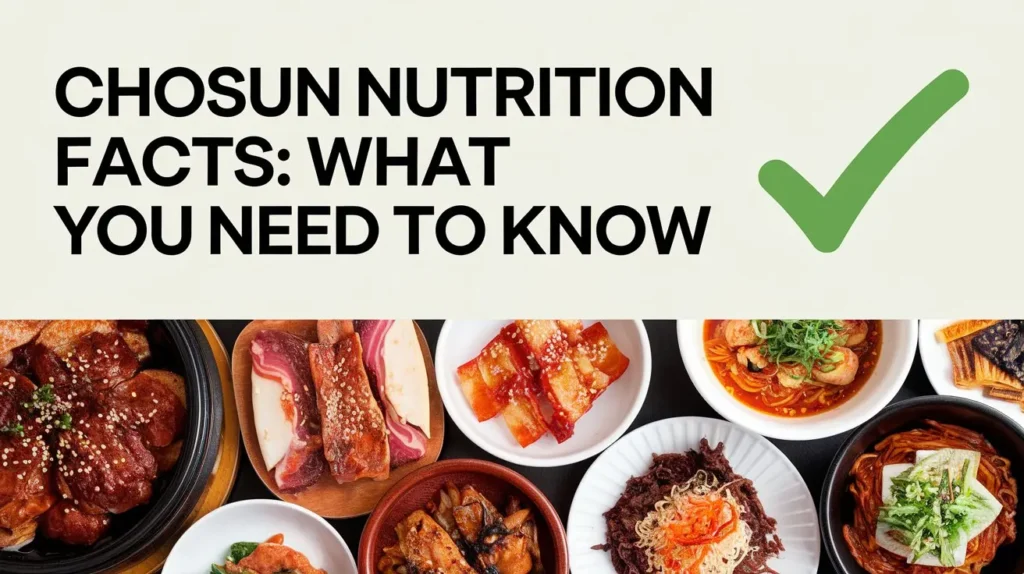Alimental Korean cuisine is known for its bold flavors, vibrant colors, and rich cultural history. Chosun, a popular Korean cuisine, features a wide array of traditional dishes, each offering unique nutrition profiles. Whether you’re a health-conscious eater or simply curious about the nutritional value of Chosun dishes, understanding the basics of Chosun nutrition facts can help you make informed choices. In this article, we’ll explore the nutrition facts of key Chosun dishes, the benefits of traditional Korean ingredients, and tips for enjoying this cuisine in a healthy way.
Overview of Korean Cuisine and Nutrition
Korean cuisine, including Chosun dishes, emphasizes balance and harmony. Meals typically include a variety of flavors—spicy, savory, sweet, and sour—alongside a mixture of vegetables, proteins, grains, and fermented foods. This balance contributes to the nutritional richness of Korean food, making it both satisfying and nourishing.
Traditional Korean dishes often incorporate whole foods like rice, vegetables, lean meats, and seafood. Additionally, fermentation is a key part of Korean cooking, providing a healthy source of probiotics through foods like kimchi and doenjang (fermented soybean paste).
Key Ingredients in Chosun Dishes
Before diving into the specific nutrition facts of Chosun dishes, it’s important to understand the key ingredients that form the foundation of this cuisine.
1. Rice
Rice is the staple of most Korean meals. White rice is the most commonly served, but brown rice and mixed grain rice are also popular. While white rice provides quick energy due to its high carbohydrate content, brown rice offers more fiber and nutrients, making it a healthier alternative.
Nutritional facts (per cup of cooked rice):
- Calories: 200-250
- Carbohydrates: 45g
- Protein: 4g
- Fiber: 0.5-3.5g (depending on rice type)
2. Kimchi
Kimchi, a fermented cabbage dish, is a staple in Chosun meals. Rich in vitamins and probiotics, kimchi provides numerous health benefits, including improved digestion and immune function. Its nutritional profile varies depending on the ingredients, but it’s generally low in calories and high in antioxidants.
Nutritional facts (per 1/2 cup):
- Calories: 15-25
- Carbohydrates: 2-4g
- Protein: 1g
- Fiber: 2g
- Probiotics: Varies by fermentation process
3. Doenjang (Fermented Soybean Paste)
Doenjang is a core ingredient in many Chosun soups and stews. Like kimchi, it’s a fermented food, making it a good source of probiotics. Doenjang is rich in protein, fiber, and essential minerals.
Nutritional facts (per tablespoon):
- Calories: 30
- Carbohydrates: 5g
- Protein: 2g
- Fiber: 1g
4. Vegetables
Korean dishes heavily feature vegetables such as spinach, bean sprouts, radishes, and zucchini. These vegetables are often lightly seasoned and served as banchan (side dishes), offering essential vitamins, minerals, and fiber without adding excess calories or fat.
Nutritive facts (per cup of mixed vegetables):
- Calories: 50-80
- Carbohydrates: 10-15g
- Protein: 2-4g
- Fiber: 3-5g
5. Seafood and Meat
While Korean cuisine is known for its vegetarian-friendly options, seafood and lean meats like beef, chicken, and pork are also common in Chosun dishes. Grilled fish, bulgogi (marinated beef), and dak-galbi (spicy stir-fried chicken) are some of the popular protein choices.
Nutritional facts of chosun grilled fish:
- Calories: 100-150
- Protein: 20g
- Fat: 2-6g (depending on the type of fish)
Nutritional facts of beef bulgogi:
- Calories: 250
- Protein: 22g
- Fat: 15g
- Carbohydrates: 7g
Breakdown of Popular Chosun Dishes
Let’s take a closer look at the nutritional facts of some well-known Chosun dishes, including how they contribute to a balanced diet.
1. Bibimbap
Bibimbap is a popular Korean dish made with rice, vegetables, meat, a fried egg, and gochujang (spicy red pepper paste). The combination of ingredients provides a well-rounded meal with carbohydrates, protein, healthy fats, and plenty of vitamins and minerals.
Nutritional facts (per serving):
- Calories: 500-600 (depending on portion size and ingredients)
- Carbohydrates: 80g
- Protein: 20-25g
- Fat: 10-15g
- Fiber: 6-8g
2. Kimchi Jjigae (Kimchi Stew)
Kimchi jjigae is a flavorful, spicy stew made with kimchi, tofu, pork, and vegetables. It’s low in calories but high in nutrients like vitamins C and K, probiotics, and protein. Kimchi jjigae is often served with a side of rice to create a satisfying and nutritious meal.
Nutritional facts (per bowl):
- Calories: 200-250
- Protein: 10-15g
- Carbohydrates: 12-18g
- Fat: 8-10g
- Fiber: 3g
3. Bulgogi
Bulgogi is thinly sliced, marinated beef that’s typically grilled or stir-fried. It’s a popular dish for meat lovers due to its tender texture and sweet-savory flavor. Bulgogi is rich in protein, iron, and B vitamins.
Nutritional facts (per 3 oz serving):
- Calories: 250-300
- Protein: 22g
- Fat: 15g
- Carbohydrates: 7g
4. Samgyeopsal (Grilled Pork Belly)
Samgyeopsal is grilled pork belly, often eaten with lettuce wraps, garlic, and dipping sauces like ssamjang. While pork belly is higher in fat, it’s usually balanced with vegetables and kimchi, which provide fiber and essential nutrients.
Nutritional facts (per 3 oz serving):
- Calories: 250-350
- Protein: 12g
- Fat: 25g
- Carbohydrates: 1g
5. Japchae
Japchae is a stir-fried noodle dish made with sweet potato noodles, vegetables, and a choice of meat or tofu. It’s light but flavorful, and the noodles provide a unique texture. Japchae is a good source of carbohydrates, fiber, and vitamins from the mixed vegetables.
Nutritional facts (per serving):
- Calories: 200-300
- Carbohydrates: 40g
- Protein: 6-10g
- Fat: 5-8g
- Fiber: 3-4g
6. Tteokbokki (Spicy Rice Cakes)
Tteokbokki is a street food favorite made from chewy rice cakes simmered in a spicy-sweet sauce. While it’s not the most nutrient-dense dish, it’s a fun and filling snack with a strong kick of flavor. Tteokbokki is higher in carbohydrates and calories due to the rice cakes but can be paired with vegetables to balance it out.
Nutritional facts (per serving):
- Calories: 300-400
- Carbohydrates: 60-80g
- Protein: 4-6g
- Fat: 5-8g
- Fiber: 2g
Health Benefits of Chosun Cuisine
Chosun dishes offer several health benefits due to their emphasis on whole, minimally processed ingredients and balanced meals. Let’s explore some of the key benefits of eating Chosun-style meals.
1. Rich in Probiotics
The fermented foods commonly found in Chosun cuisine, such as kimchi, doenjang, and ganjang (soy sauce), are rich in probiotics. Probiotics are beneficial bacteria that support gut health, improve digestion, and boost immune function.
2. High in Fiber
Many Korean dishes include vegetables and whole grains, both of which are excellent sources of fiber. Fiber is essential for digestive health, and it can help regulate blood sugar levels and lower cholesterol. Dishes like bibimbap and japchae provide ample fiber from their mix of vegetables.
3. Balanced Macronutrients
Korean meals often include a balance of carbohydrates, protein, and fats, which is essential for a well-rounded diet. For instance, bibimbap contains rice for carbohydrates, vegetables for fiber and vitamins, and meat or tofu for protein. This balance ensures that you get the nutrients you need in a single meal.
4. Low in Processed Foods
Chosun cuisine uses whole, natural ingredients and minimal processed foods. Instead of relying on artificial additives, Chosun dishes draw flavor from fresh vegetables, spices, and fermentation. This makes Korean food a healthier alternative to many modern diets that rely heavily on processed products.
5. Moderate Portions
Korean meals often consist of small, manageable portions served with banchan (side dishes), which encourages mindful eating. The variety of dishes on the table helps to prevent overeating by offering a range of flavors and textures, making it easier to stop when you’re full.
Tips for Healthy Eating with Chosun Cuisine
To maximize the health benefits of Chosun cuisine, follow these tips:
- Opt for Whole Grains: When available, choose brown rice or mixed grains over white rice for added fiber and nutrients.
- Load Up on Vegetables: Focus on vegetable-rich dishes like bibimbap, japchae, and kimchi. These provide essential vitamins and minerals without adding excess calories.
- Watch Sodium Intake: While fermented foods are healthy, they can be high in sodium. Balance your intake of salty foods like kimchi, doenjang, and soy sauce with fresh vegetables and plenty of water.
- Limit Fatty Meats: Choose leaner cuts of meat like grilled fish, chicken, or tofu over fattier options like samgyeopsal or beef bulgogi.
- Practice Portion Control: Enjoy small portions of high-calorie dishes like tteokbokki, and pair them with lighter sides like salads or kimchi.
Conclusion
Chosun cuisine offers a delicious and nutritious way to enjoy Korean food. By understanding the nutrition facts of Chosun dishes and making mindful choices, you can enjoy a healthy and balanced diet while indulging in rich flavors. Whether you’re a fan of bibimbap, kimchi jjigae, or bulgogi, Chosun dishes provide a wide array of health benefits thanks to their fresh ingredients, fermented foods, and balanced meals.



